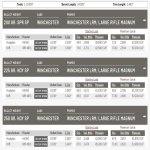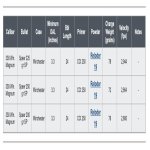You are using an out of date browser. It may not display this or other websites correctly.
You should upgrade or use an alternative browser.
You should upgrade or use an alternative browser.
does this load data look ok to you?
- Thread starter eschafer
- Start date
- Location
- Saskatchewan
Yes, you are missing something. But who knows what. Data is gathered by bullet and powder companies for their manuals from past ballistic tests, and not all of those tests are always conducted at the same time with the same test components. this seems like a good reason to compare with other manuals with similar components for a relative reality check, before you work up your own load in your own firearm which is a whole 'other' set of variables.
Yes, that's a curious trend, with the 225-gr. bullet the one that seems out of place charge-wise. I went to the Speer Manual #12 and found the figures you presented. They are all maximum loads. As you've noted, normally there's a fairly-common linear trend with lighter bullets requiring a larger powder charge than heavier bullets. I looked at some other powders for the .338 WM in the same Speer tables, and the the non-linear trend appears with some other powders as well. You're not missing something; sometimes with reloading you get seemingly anomalous results. I think you can be sure that this is not an error in publication. Speer (like everyone who publishes reloading manuals) would have carefully checked their recommended loads. I'd just write it off to one of many curiosities that we encounter in our reloading activities.
not that it makes much difference but this capture is from Alliant's Load Data site.... I do understand that figures for powder were at max load.. and to reduce 5-10% to start... Intuitively, I thought figures for the two bullets were interchanged mistakenly, but perhaps it's written as intended... Thought it was prudent for others to look at this too and get some welcomed expert thoughts on it... Thanks...
Last edited:
Yes, don't assume that the figures were interchanged. I think we can assume that this is just as Speer wanted it presented. For what it's worth, for some other powders with those bullets--H4350, H4831--the max charges for the 200-gr. and 225-gr. bullets are identical, and with IMR7828, the linear trend is what you'd expect, with max loads of 81-gr. for the 200-gr. bullet and 75-gr. for the 225.not that it makes much difference but this capture is from Alliant's Load Data site.... I do understand that figures for powder were at max load.. and to reduce 5-10% to start... Intuitively, I though figures for the two bullets were interchanged mistakenly, but perhaps it's written as intended... Thought it was prudent for others to look at this too and get some welcomed expert thoughts on it... Thanks...
I saw a similar thing many years ago and looked into when I was retained as a consultant for the company.
It turned out that the load data had been developed at different times with different lots of powder in different guns.
I tried to explain to the powder maker that we handloaders find this kind of thing disconcerting. They did not get it. They are chemists - not shooters.
It turned out that the load data had been developed at different times with different lots of powder in different guns.
I tried to explain to the powder maker that we handloaders find this kind of thing disconcerting. They did not get it. They are chemists - not shooters.
When you see stuff like that just approach the lower figure cautiously, maybe you can work past it, maybe not, don't know til you try. PITA, but, that's all you can do. I can tell you I put 75gr RL19 in with a 210 Nos, and got better speed than that by 150fps on a Rem700 I had.
But, that is maybe a difference in the powder lot, probably some due to bullet, some due to gun. I got 2440 from Fed Premium 250nos loads in that gun, box said 2660, I was pleased with using H4831 in it, got 2750.
But, that is maybe a difference in the powder lot, probably some due to bullet, some due to gun. I got 2440 from Fed Premium 250nos loads in that gun, box said 2660, I was pleased with using H4831 in it, got 2750.
why would they load less powder for a lighter bullet, for less velocity? Looking specifically at 200 and 225 gr. bullet loads... error in publication, or am I missing something?
Alliant has great powders and a terrible load data website.
It has every appearance that the numbers for the 200 and 225 gr bullets are interchanged as suggested. The bullets are all of the same construction and general profile, and two more grains of the same powder in a bullet weighing 25 grs more would not increase the MV much if at all, much less 136 fps. That said, again as already suggested, Alliant does not seemed inclined to understand the error, much less correct it.
As a sanity check, look at Hodgdon's excellent load data for similar bullets and powders in the same burn rate neighborhood as Reloder 19 - declining MV's and declining powder charges for ascending bullet weights:










































































